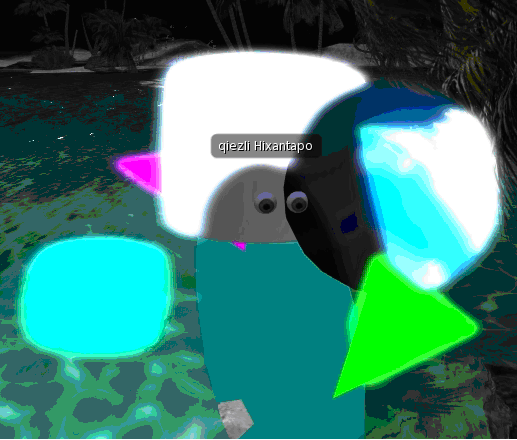 "The Thing Growing" (2000) by Josphine Anstey.
"The Thing Growing" (2000) by Josphine Anstey.
"The Thing Growing" by Josephine Anstey (2000).
Qiezli's visual design was subconsciously influenced by Josephine Anstey's interactive virtual character "The Thing" from "The Thing Growing" (2000).
It was only in 2011 where this visual influence was clearly remembered. As a result, correlations between Qiezli and "The Thing" became more explicit over time...
Unlike Anstey's Thing, however, Qiezli was not designed with any narrative or socially-dependent purpose other than to exist "for art's sake".
Resembling an embodied configuration of abstract modules, Qiezli’s visual design is intentionally non-anthropomorphic. Qiezli’s gender-neutral body is composed out of a variable array of floating illuminated video-textured 3D geometrically primitive shapes called prims. In other words, Qiezli constantly shifts its outward visual appearance. Qiezli’s core anthropomorphic avatar base form (as pre-determined by SL’s interface) is completely invisible. This invisible humanoid avatar acts as a placement axis for the manifestation(s) of varying video-prim objects that represent its limbs and face (including eyes). Similarly, Anstey’s “Thing” relies on geometrical limbs (pyramids) and other “body parts” that “could be substituted” (Anstey 2000). Qiezli’s modularity is emphasized more than Anstey’s agent because new body-parts “grow” from invisible stems in a generative manner. Qiezli’s perpetual limb-substitution activity becomes a key component of its perceived gestalt visual design. Therefore, users’ gestalt interpretations of Qiezli’s body schema helps sustain a “strong illusion of an autonomous being formed from a collection of primitive shapes” (Anstey 2000). As with Anstey’s agent, the illusion that Qiezli is a single entity “is not broken by parts of the body joining badly”. In order for such configurations to minimally engage anthropomorphic coherence, both Anstey’s “Thing” and Qiezli employ non-verbal dance-gestures to express a feigned emotional connection with the user(s).

No comments:
Post a Comment